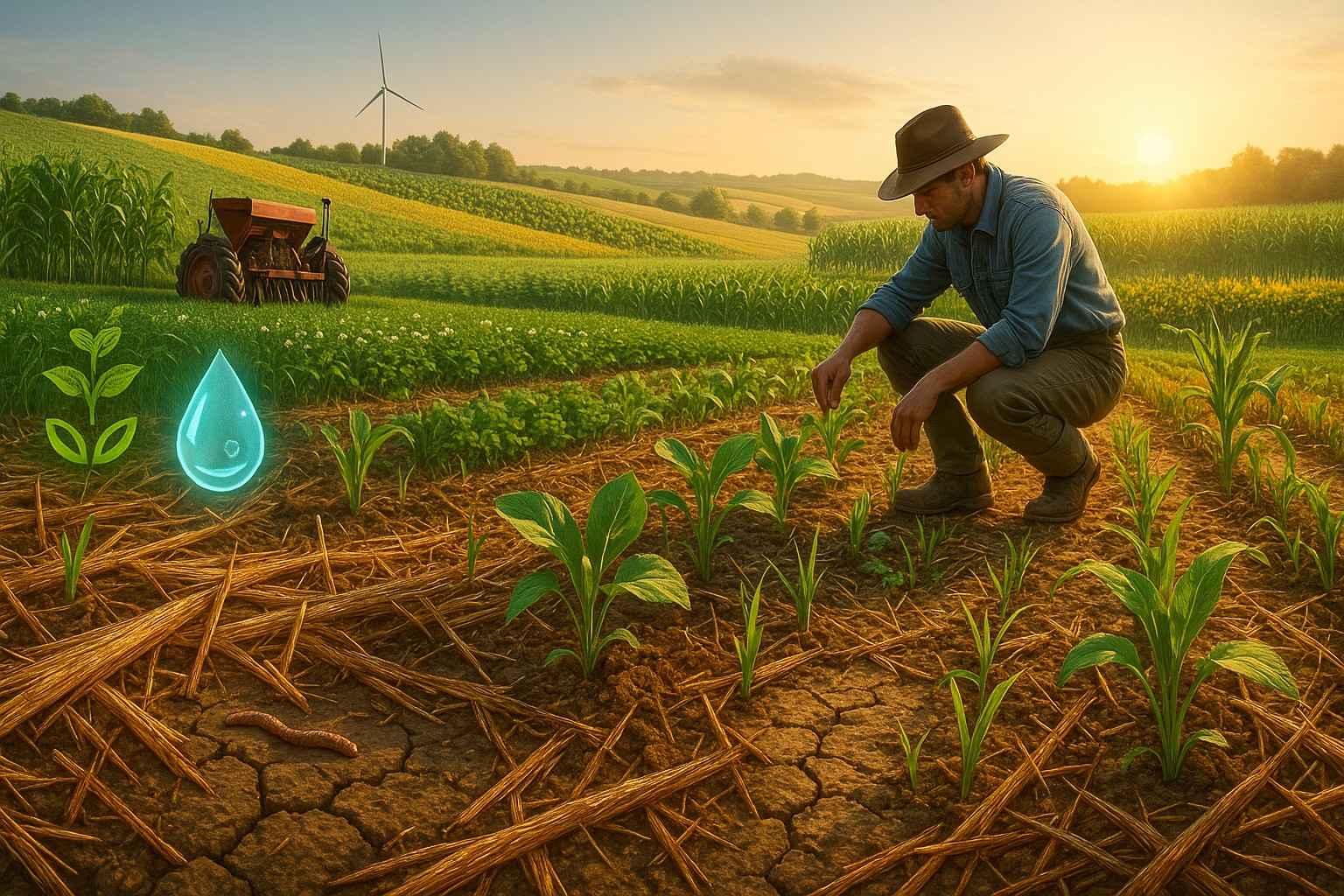Agriculture has been the backbone of human civilization for thousands of years, providing food, fiber, and livelihoods for a growing global population. However, the expansion and intensification of conventional farming practices over the past century have come at a significant cost to the environment. Excessive tillage, monocropping, heavy use of chemical fertilizers and pesticides, and inefficient water management have led to severe soil degradation, loss of biodiversity, water scarcity, and increased greenhouse gas emissions. In the face of these environmental challenges and the pressing need to ensure food security for a projected 9 billion people by 2050, there is an urgent demand for sustainable and resilient farming systems. One such promising solution is Conservation Agriculture.
Conservation Agriculture (CA) is a farming approach that seeks to achieve sustainable and profitable agriculture by maintaining and improving the natural resource base. It is based on three core principles: minimum mechanical disturbance of the soil (no-till or reduced tillage), permanent soil cover with crop residues or cover crops, and diverse crop rotations or associations. These principles are designed to work in harmony with natural ecological processes, enhancing soil health, increasing biodiversity, and reducing the need for synthetic inputs.
The first principle—minimal soil disturbance—involves reducing or eliminating traditional plowing and tilling practices. This helps preserve soil structure, reduce erosion, and promote the growth of beneficial soil organisms. The second principle—permanent soil cover—protects the soil from erosion, conserves moisture, regulates temperature, and provides organic matter as the residue decomposes. The third principle—diversification through crop rotation—helps break pest and disease cycles, improves soil fertility, and reduces the dependency on chemical inputs.
Unlike conventional agriculture, which often relies heavily on external inputs and mechanical intervention, Conservation Agriculture emphasizes working with nature rather than against it. It is a flexible system that can be adapted to various climates, soil types, and socioeconomic conditions, making it suitable for both large-scale commercial farms and smallholder farmers in developing regions.
Globally, Conservation Agriculture has gained momentum, particularly in countries like Brazil, Argentina, the United States, and parts of Africa and Asia. Its benefits are wide-ranging: improved soil fertility, reduced input costs, enhanced resilience to climate extremes such as drought and floods, and even carbon sequestration that contributes to climate change mitigation. At the same time, CA promotes long-term productivity, making it a viable solution for sustainable food production.
However, the adoption of Conservation Agriculture is not without challenges. It requires changes in farming mindsets, access to appropriate tools and knowledge, and supportive policies and markets. Transitioning from conventional to conservation practices often involves an initial period of adjustment, both technically and economically.
In conclusion, Conservation Agriculture offers a forward-thinking and ecologically sound alternative to traditional farming. By protecting the natural resource base, enhancing productivity, and improving resilience to climate variability, it represents a sustainable pathway toward global food security and environmental resilience. As the world faces increasing pressures from population growth and climate change, embracing and promoting Conservation Agriculture could be key to securing a healthy planet and prosperous farming communities.
- Core Principles of Conservation Agriculture
Conservation Agriculture is grounded in three fundamental principles that work together to enhance soil health, boost productivity, and ensure environmental sustainability:
1. Reduced or No Soil Disturbance
This principle emphasizes minimizing mechanical disruption of the soil through practices like no-till or reduced tillage farming. By avoiding frequent plowing, the natural structure of the soil is preserved, which improves water infiltration, reduces erosion, and supports the growth of beneficial soil organisms. It also minimizes carbon loss from the soil, contributing to climate change mitigation.
2. Continuous Soil Cover
Maintaining a permanent organic cover on the soil surface is essential for protecting it from wind and water erosion. This is achieved through the use of crop residues, cover crops, or mulching materials, which not only shield the soil but also help retain moisture, regulate soil temperature, and suppress the growth of weeds. Over time, this cover contributes organic matter to the soil, enriching it naturally.
3. Crop Diversification through Rotation or Intercropping
Implementing diverse crop rotations—especially by incorporating nitrogen-fixing legumes—helps break pest and disease cycles, reduces dependency on chemical inputs, and enhances overall soil fertility. Rotating different types of crops seasonally or practicing intercropping encourages biodiversity both above and below the soil, leading to more resilient and productive farming systems
Benefits of Conservation Agriculture
1. Environmental Benefits
a. Soil Health Improvement
- Enhanced organic matter content.
- Improved soil structure and water infiltration.
- Reduced erosion and runoff.
b. Water Conservation
- Residue cover reduces evaporation.
- Better water retention helps in drought-prone areas.
- Lower irrigation requirements.
c. Carbon Sequestration
- CA helps capture atmospheric carbon in soil organic matter, mitigating climate change.
d. Biodiversity Enhancement
- Promotes habitat for soil organisms, insects, and wildlife.
- Diverse cropping systems support broader ecosystems.
2. Economic Benefits
a. Reduced Input Costs
- Less fuel and labor due to reduced tillage.
- Lower use of fertilizers and pesticides in the long run.
b. Increased Yield Stability
- Improved soil health leads to more consistent yields.
- Better resilience against extreme weather.
c. Market Access
- Growing demand for sustainably grown products.
- Certification opportunities for eco-labeling.
3. Social Benefits
a. Improved Livelihoods
- Enhanced productivity can improve food security and income.
b. Knowledge Sharing
- Encourages community-based learning and innovation.
c. Empowerment of Marginal Farmers
- Lower input costs can benefit smallholders with limited resources.
- Challenges in Adoption
Despite its many benefits, the widespread adoption of Conservation Agriculture faces several barriers:
1. Initial Transition Costs
- Purchasing no-till equipment and cover crop seeds can be costly.
- Farmers may experience yield reductions during early years of transition.
2. Knowledge and Awareness Gaps
- Lack of access to training and information, especially in developing countries.
- Traditional beliefs and resistance to change.
3. Policy and Institutional Support
- Insufficient government incentives or subsidies for CA adoption.
- Lack of integration into national agricultural policies.
4. Market Limitations
- Limited markets for diverse crops grown in rotation.
- Difficulty in certifying and monetizing environmental benefits.
Conservation Agriculture Around the World
South America
- Brazil and Argentina are pioneers in CA adoption, especially in large-scale mechanized farming.
- Over 50% of cultivated land in these countries uses no-till systems.
North America
- The United States and Canada have significant no-till acreage.
- Strong extension services and research institutions support adoption.
Africa
- CA is promoted in sub-Saharan Africa, especially among smallholders.
- Projects in Zambia, Kenya, and Ethiopia show promising results, but adoption remains low due to barriers like tool availability and awareness.
Asia
- India and China are promoting CA to address soil degradation and climate vulnerability.
- The Zero Tillage Rice-Wheat System in the Indo-Gangetic Plains is a notable success story.
Europe
- Adoption is slower but increasing, particularly in countries with supportive agri-environmental policies.
- EU’s Common Agricultural Policy (CAP) provides incentives for sustainable practices.
Technology and Innovation in Conservation Agriculture
Technological advancements are playing a crucial role in the proliferation and effectiveness of CA practices:
1. Precision Agriculture
- Use of GPS-guided machinery to minimize disturbance.
- Sensors for soil health monitoring and variable-rate input application.
2. Biological Inputs
- Use of biofertilizers, mycorrhizal fungi, and organic composts to enhance soil fertility.
3. Mechanization for Smallholders
- Development of affordable, small-scale no-till planters and seeders.
4. Digital Platforms and Mobile Apps
- Access to training, weather forecasts, market prices, and remote advisory services.
Policy and Institutional Support
Successful implementation of Conservation Agriculture requires coordinated efforts across multiple levels:
Government Initiatives
- Subsidies for CA equipment.
- Crop insurance schemes for risk management.
- Integration into national climate adaptation strategies.
NGOs and Civil Society
- Community mobilization and training programs.
- Farmer field schools and demonstration plots.
Research and Academia
- Ongoing studies on best practices, crop varieties, and soil interactions.
- Collaboration with international research centers.
International Support
- Programs by FAO, World Bank, and IFAD to promote CA in developing countries.
- Climate finance mechanisms (e.g., Green Climate Fund) for sustainable agriculture.
Future Prospects of Conservation Agriculture
The future of Conservation Agriculture is promising, particularly as global priorities shift toward sustainability, food security, and climate resilience. However, several key actions are needed:
1. Scaling Up Efforts
- Bridging the gap between small-scale trials and large-scale implementation.
2. Integrating Climate-Smart Agriculture
- CA is a cornerstone of climate-smart agriculture, which seeks to increase productivity, adapt to climate change, and reduce emissions.
3. Youth and Gender Inclusion
- Engaging women and youth in CA offers opportunities for innovation, employment, and empowerment.
4. Global Collaboration
- Sharing best practices and innovations across borders.
- Creating global networks of conservation agriculture practitioners and researchers.
Conclusion
Conservation Agriculture (CA) is a forward-looking and sustainable farming approach that balances agricultural productivity with environmental stewardship. By focusing on key principles such as minimal soil disturbance, permanent soil cover, and diverse crop rotations, CA nurtures the health of soil and ecosystems while ensuring long-term crop yields. This method not only enhances soil fertility and water retention but also reduces greenhouse gas emissions, making it an effective strategy to address climate change and land degradation.
CA is particularly valuable in the face of growing global challenges such as food insecurity, erratic weather patterns, and the degradation of natural resources. Its widespread adoption can lead to healthier soils, more stable farming incomes, and greater resilience against droughts and floods. However, for Conservation Agriculture to succeed on a large scale, it requires strong policy support, access to appropriate technologies, farmer education, and active community participation.
Global collaboration among governments, research institutions, NGOs, and farming communities is essential to promote and scale CA practices. With collective effort, Conservation Agriculture can become a cornerstone of sustainable development, offering hope for a more resilient, productive, and environmentally sound agricultural future for generations to come.
– Dr. Rushita Kotadiya,Department of Agronomy
College of Agriculture, Madhav University

